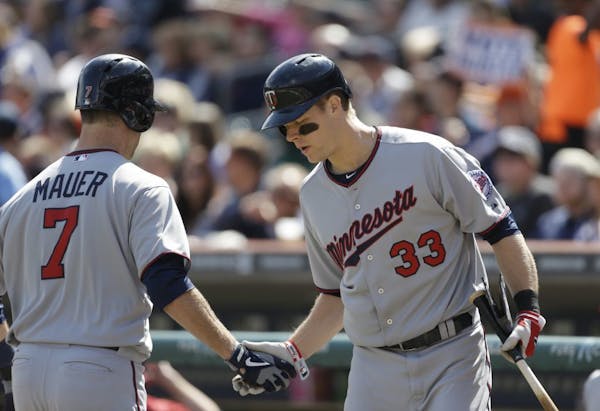In a way, Mike Pelfrey and Vance Worley are doing the Twins a favor. They're the ruler slaps across the knuckles that remind the transgressor of the rule.
Here's the rule: When big-league starters are available, you probably don't want them. They're like the burned hot dogs that sit on the back of the grill all day at a yard party. Nobody has touched them for a reason.
There are exceptions to this rule, including Carl Pavano performing well for the Twins in 2010 and Kevin Correia giving the Twins a couple of good months to start 2013, but they are short-term exceptions.
If a big-league team is willing to trade a starting pitcher in a business where the motto is ''You can never have too much pitching,'' there is something wrong with the guy.
If a pitcher becomes available in free agency, he will be overpriced and risky, because signing him will require outbidding 31 other teams for a player who has logged enough innings to drive up his price.
Trading for Worley seemed logical. The Twins sent a center fielder who is not in their long-term plans, Ben Revere, to Philadelphia for a starting pitcher who two years ago finished third in the National League rookie of the year voting while performing in a pennant race.
This week, the Twins, citing Worley's 7.21 ERA, sent him to Class AAA. It turns out that all you needed to know about Worley was that the Phillies were willing to trade him.
Signing Pelfrey seemed logical. He's been a winner in the big leagues, and undergoing Tommy John surgery a year ago made him affordable and available. It turns out all you needed to know about Pelfrey was that he was affordable.
What's remarkable about the Twins' failings in the free-agent pitching market, dating to 1993, is that the organization has proved so adept in acquiring talent by almost any other method. The Twins have acquired about as many quality pitchers via the Rule V draft, a mechanism for picking up minor league players other organizations have given up on, than in free agency and via trades for big-leaguers.
The Twins acquired Johan Santana in the Rule V draft, through a trade with Houston. They also used the Rule V draft to land Scott Diamond, their best pitcher last season, and reliever Ryan Pressley, who has impressed this season.
Here's a list of some of the pitchers who were in or on the cusp of the big leagues when the Twins acquired them: Pavano, Philip Humber, Kevin Mulvey, Livan Hernandez, Carlos Silva, Ramon Ortiz, Sidney Ponson, Terry Mulholland, Rick Reed, Kenny Rogers, Sean Bergman, Bob Tewksbury, Mike Morgan, Rich Robertson, Scott Aldred, Scott Klingenbeck, Jose Parra, Greg Harris, Jim Deshaies, Greg Brummet.
Silva, Reed, Rogers and Pavano offered short-term value. Many of those pitchers contributed to the Twins' eight consecutive losing seasons from 1993-2000, and many of the rest were placeholders offering innings while the Twins tried to replace them with someone younger and better.
Here's a list of some of the starting pitchers the Twins developed themselves, either after drafting them or trading for them while they were in the minor leagues: Santana, Diamond, Joe Mays, Eric Milton, Nick Blackburn, Kevin Slowey, Eddie Guardado, LaTroy Hawkins, Kyle Lohse, Boof Bonser, Glen Perkins, Matt Garza, Francisco Liriano, Scott Baker.
Guardado, Hawkins and Perkins were drafted as starters and converted to relievers. In total, 13 of those 14 pitchers (leaving out Diamond, the newcomer) were the difference between the losing Twins teams in the '90s and the winning Twins teams that followed.
They were productive for the organization that raised them while they were young and affordable. The list of big-league pitchers who have signed massive free-agent deals and then failed, either because of injury or an inability to maintain excellence, is long and cautionary.
In the '90s, Twins General Manager Terry Ryan tried to patch holes in his rotation with free-agent mediocrities. This season, he tried to patch holes in his rotation with big-leaguers who had experienced success in the past but were coming off injuries. The results are the same.
''We've always been able to do something to put a bullpen together, but starting pitching is different,'' Ryan said. ''It's the most valuable piece to anybody's roster, and to do it right, I think the important thing is to make sure you have people who can give you close to 200 innings. The days we were solid in the rotation, you would look at it in spring training and expect 200 innings out of four or five starters.
''Any organization that can do that is going to be good. Obviously, we've struggled in that area the last three years, so we've set our objective the last two years as looking for guys who can give us those type of innings.''
The Twins became the best story in baseball in 2001 when their young pitchers were ready to win. They'll rise again if and when their pitching prospects —led by Kyle Gibson, Alex Meyer, Trevor May and Jose Berrios — give them a collection of young, affordable, durable, hard-throwing starters.
Until they arrive, it's time to dig out your old Scott Klingenbeck baseball cards.
Good times.
Jim Souhan can be heard weekdays at noon and Sundays from 10 to noon on 1500 ESPN. His Twitter name is @SouhanStrib. jsouhan@startribune.com

Souhan: This is KAT's chance to prove Flip Saunders was right

Souhan: Why Tiger Woods should keep swinging
Souhan: Scheffler wins Masters again, shows what makes him special
Morikawa falters in final round at Masters


